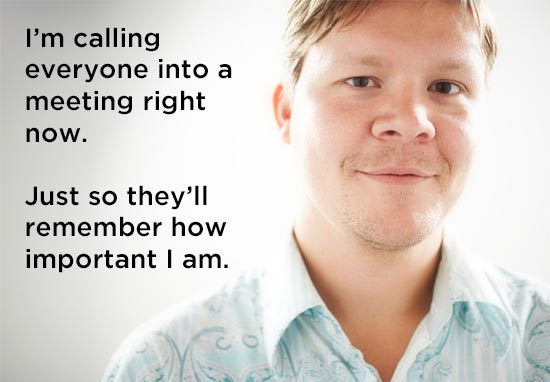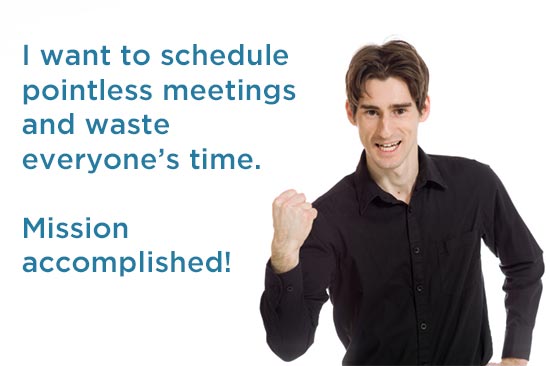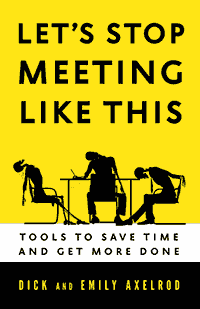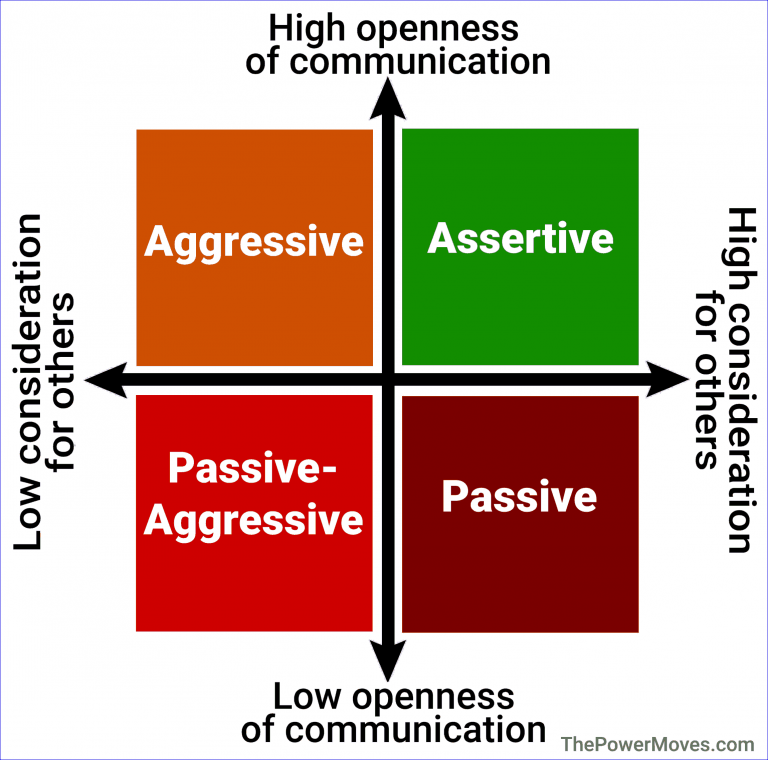Reject the Hype and Fix Your Bad Meetings
The Hype: Meetings Waste People’s Time and Money
Have you seen the studies about the state of meetings in the workplace today? If not, here’s a sampling:
- An estimated 36 to 55 million meetings occur in the USA each day and billions are lost annually thanks to unproductive meetings.1
- David Coleman estimated that 25% of that time wasted.2
- In 2013, employees chose “too many meetings” as the biggest distraction and waste of time presented by the workplace.3
- A ResourcefulManager survey of 948 upper-level executives, directors, middle managers and frontline supervisors says nothing gets accomplished in 44.8% of the meetings executives and managers attend.4
The most popular article about this problem on social media today implores us to please strive for “Meetings that Don’t Suck”. Run a Google search for meetings that don’t suck, and you’ll see pages of articles on that theme.
Nowhere else in the business world do we see so much advocacy for such a pathetic goal.
No one says “Hey everyone, can we please just not suck too bad at customer support? How about we try not to suck at sales?”
The studies paint a dire picture. Apparently, untold masses sit helplessly as the precious hours of their lives are wasted, watching in resignation as their time is stolen from them by forces so pervasive, so insipid, and yet so powerful that none can stand against them. Even the people trying to make a difference offer slim hope, holding out the possibility that if you try your best, you could maybe not suck so hard.
We’re led to believe that bad meetings are an intractable problem. But that’s not quite the right story, is it?
The Reality: Meetings don’t waste people’s time.
People waste people’s time.

Despite all the hype and popular misconceptions, meetings are neither inherently good nor bad. A meeting is simply one of the many ways you can communicate with a group.
Just like with email, chat, and social media, what and how you communicate in meetings can inform and empower, or it can take what few moments you have left on this earth and leave them hollow.
This isn’t the meeting’s fault! Meetings don’t just happen. A bad meeting is the fault of the person running the meeting, and of those participating (or more likely, not participating).
I’m telling you, bad meetings are Soylent Green. They’re made out of people!
This is good news! If bad meetings happen because people choose to run bad meetings, it means that people could make a different choice. They could choose to run excellent meetings.
But, why would anyone choose to run a bad meeting in the first place?
Are we surrounded by time cannibals?!!
The mostly untrue and unfair reasons you believe people run bad meetings
If you know the difference between a good meeting and a bad meeting, you will feel instantly frustrated and perhaps even insulted when you’re asked to participate in a bad one.
You’ll be tempted to judge the meeting leader, and given the strong negativity bias wired into our human nature, your judgment will not be kind. You’ll start to think that maybe:
- They’re incompetent.
- They don’t care about getting anything done.
- They don’t respect you or your time.
- They’re on a power trip.

I know I’ve felt this way before, and maybe sometimes those impressions are spot on. Most of the time, though, please keep in mind:
Never attribute to malice that which can adequately be explained by misunderstanding or neglect.
a combo of Goethe & Hanlon’s razor
Sometimes when I’m on a terrible sales call, I start to think the reps never actually wanted my business, and they’re using their awful meeting to ward me off. But since they work on commission, that literally doesn’t add up.
And do you honestly believe your boss wants the team to get paid for sitting around in meetings where nothing gets done? Where you make uniformed, bad decisions that shape the future of the company?

When you think about it, it doesn’t seem likely that people are actually trying to run bad meetings. So what’s really going on?
The 3 REAL Reasons People Run Bad Meetings
Ok, maybe some people really are incompetent maniacal time-wasters, but let’s agree that those are the exceptions.
Most often, people run bad meetings for one of three reasons.
Reason 1: They don’t know how to run a good meeting.
This is not to say that they can’t tell when their meetings suck. The studies I cited above show that lots of people know they have a meeting problem. They just don’t know how to fix it.
Why?
A. They don’t have good examples to follow.
When they started their career, they were asked to join the team’s regular meetings, none of which had an agenda or clear result.
If they attended a meeting with an agenda, they thought it was a special event. Like that time they got to present to the board, or the new product kickoff with the sales team.
Their managers and leaders ran bad meetings, and when they move into management themselves, they perpetuate these examples.

I’ll talk more about the impact of workplace culture on meetings below.
B. Most advice isn’t useful.
When you search the internet for information on how to run a good meeting, you’ll find lots of articles outlining 8 to 15 key steps you must take. Things like:
- Keep it short
- Create an agenda
- Only invite the right people
But – how exactly do you do that?
How do you “only invite the right people” to a client demo, or a committee meeting?
Keep it short? Ok, but how do you do that for a strategic planning session or a board off-site?
Create an agenda? Fine. How? Where should you start, and where should you end? How many topics should go on that agenda? What if I’m having trouble with a stand-up or huddle meeting? How do we use an agenda then?
How to run a meeting well depends entirely on the kind of meeting you need to run.
Consider this article by Buffer: 9 Science-Backed Methods for a Happier, More Productive Meeting. Most of this advice is solid – for some meetings – but should you actually try to follow all the advice in the same meeting, or the wrong kind of meeting, you’d find yourself in a pickle. No devices or computers, use a timer, keep it to 15 minutes or less, have 2 minutes of silence, stand up, take notes on paper? And pat your head whilst rubbing your tummy too, just to make it interesting.
Telling people with a meeting problem to just “make an agenda and keep it short” is like telling an overweight person to just “diet and exercise”. The advice isn’t wrong, but it’s not directly actionable either. Just as the “diet & exercise” mantra doesn’t help someone fill out a grocery list, telling someone to “make an agenda” doesn’t give you any hints about what that agenda should look like.
It’s just enough information to let you know you’re doing it wrong, so you can feel bad about yourself.
Solution: 5 Practical Steps to Learn How to Run Meetings Well
If usable meeting know-how is a problem in your organization, follow these practical steps to go beyond the basics and learn what works for the kinds of meetings you run.
1. Read a book.
Advice on the internet can point you in the right direction, but you’ll need to go a bit deeper before you can put it into practice. There are lots of books on running effective meetings, many of which are breezy reads.

Right now, I’m particularly fond of Dick & Emily Axelrod’s quick-reading book “Let’s Stop Meeting Like This”. Their “meeting canoe” framework provides a solid foundation for building all kinds of useful agendas. Good stuff.
2. Discover the best practices for your job.
Every role in the knowledge economy has a set of core meetings to run, and for each of those meetings, there is an established set of best practices. You need to learn them.
You must get specific. Don’t try to fix meetings in general; fix your bad meetings.
Are you a team leader? Learn the best practices for:
- weekly team meetings,
- clearing questions and handling complaints,
- one-on-ones,
- emergency response meetings,
- and planning sessions.
Do you work in HR? Learn about how to meet well when:
- interviewing,
- on-boarding new hires,
- conducting performance reviews,
- coordinating exit interviews, and
- scheduling benefits reviews.
Project management? Learn about:
- kick-offs,
- stakeholder interviews,
- project planning,
- stand ups,
- internal and client demos,
- checkpoints,
- change request approvals,
- launch reviews,
- and retrospectives.
And so on, and so on, and so forth. If you have a job that requires you to meet, there is an established methodology and set of best practices specifically for those meetings that you should know.
3. Practice.
If you run meetings, start using what you’ve learned. It doesn’t have to be perfect or complete to make a difference – start simple. For example, you might start your next meeting by stating the goal of the meeting up-front and end it by making sure you hit that goal. When that feels good, introduce an agenda.
If you aren’t the meeting leader, you can practice what you’ve learned by asking questions that help the group stay focused, and by increasing your participation. Volunteer to take notes, and use that opportunity to get clarification on decisions and next steps. More on this below.
4. Get feedback.
Once you start actively planning and running your meetings, ask the group for feedback. What’s working? What isn’t?
Asking for feedback lets everyone know that you care about running a good meeting, and you respect their input. Not only will you possibly get some helpful advice, you’ll help other people start thinking seriously about running better meetings too.
5. Get training.
Finally, after you feel you have the basics in hand, it’s time to seek professional training. Again, the kind of training that will help you most depends on your job. With just a little searching, you can find training on running agile sessions, leadership meetings, board meetings, group facilitation, usability interviews, HR calls, online meetings in general … you name it. Many programs are offered online, and most take one to four days to complete.
Reason 2: They know how to run a good meeting,
but they don’t have time.
Many folks know the basics; create an agenda, trim the invitation list, clarify the purpose, etc.
It’s easy to spit out the list of best practices. It’s hard to actually follow them all. Preparing for and leading a truly worthwhile meeting requires a significant investment of time. As anyone who writes blog titles will tell you, it’s challenging to put your ideas into the clear, short sentences you’ll need in the agenda.
To get a sense of how much time it takes, try this.
Timed Exercise: Clarity of Purpose
Step 1: Start a timer.
Step 2: Look at the next 5 meetings on your calendar.
Step 3: For each one:
- Write down the meeting purpose
i.e., why does that group of people need to meet at that time.
Make sure to write this in a way that can be shown to everyone invited. - Write down the expected result. It should look something like this.
Once we have _______________ , the meeting is over.
examples: a decision on this issue, clear next steps and assignments, a list of issues to resolve, a plan
Step 4: Record your total time.
How long did that take? If your next five meetings are mostly the same meeting repeated, it probably didn’t take too long. (That begs the question, do you really need to achieve the same thing 5 times in a row?) But if each of those meetings was different, that exercise can be challenging.
Here’s the kicker: to run meetings well, each and every meeting must have a clear purpose and expected result, and that’s just the prerequisite. Once you figure out why you’re meeting and what you need to do, then the real work can start.
Then, you need to figure out:
- Who to invite
- How to invite them, and what the invitation needs to include
- When to meet
- Where/how to meet
- How to use the meeting technology
- The Plan, or agenda
- Required reference material: presentations, a script, records to review, etc.
- What everyone else needs to prepare
- Who will do what in the meeting: note taking, presenters, etc.
A lot of detail-oriented work, and most people simple don’t have time for it on a consistent basis.
Instead, overloaded people who are otherwise knowledgeable and well-meaning run “just ok” meetings. They know they didn’t do a great job, but they don’t have time to do better.
Mediocre becomes the new best, the example they put out for those around them, and the predominant habit in their workplace. Queue the researchers: we’ve just created more evidence that meetings waste time!
Solution: How to Run Decent Meetings When You’re Super Busy
You can’t eliminate all the hard work involved in running a good meeting, but you can greatly reduce it by cutting the number of things you have to figure out each time.
Seek to automate everything that can be automated, to prepare and organize meeting tools for easy re-use, and generally reduce the cognitive overhead involved in running a meeting.
Here’s how.
1. Use a standard process for your most common meetings.
As discussed above, somewhere out there you can find best practices for most meetings. Create a set of meeting templates based on these best practices for the meetings that you run most often.
This lets you do most of the agenda planning work once, so for each meeting you’ll only need to spend time on small adjustments.
Bonus: when you start your meeting planning on a solid base, you free up the time needed to make it really excellent. Instead of starting from zero and maybe getting to a 60% decent plan, you start from 70% and work to fine-tune that last 30%.
2. Use software to automate most of the work.
Save time by using technology to eliminate any steps that require you to switch tools, copy and paste, or send lots of email back and forth.
Lucid Meetings automates as much of the work required for leading an excellent meeting as possible, and this is my first recommendation. I am entirely biased, of course.
While Lucid is the most comprehensive option available, we’re certainly not alone. You can find software that helps just with meeting scheduling. You can build agenda templates using Word or Google Docs or Evernote, or you can find meeting productivity software that will help you keep track of your decisions & action items.
If you tend to meet in person, your technology will be different, but you should aim to achieve the same goal. Spend time stocking your conference room with a facilitator’s toolkit and some quick reference sheets for the most common agendas and exercises you run.
3. Share the responsibility with the meeting participants.
Finally, you can reduce the burden of leading a meeting well by sharing it with the other people involved.
During your meeting introductions, ask everyone what they hope to achieve in the meeting, and get their commitment to reaching those goals.
While it’s the leader’s job to create the conditions for success in the meeting, the leader can’t ever achieve success on their own anyway. When you actively enlist the help of everyone else there, the resulting engagement can overcome many deficiencies created by rushed or incomplete planning.
Reason 3: They don’t feel it’s safe to try running better meetings where they work.
Some workplaces – ok, many workplaces – don’t expressly support people who try to run meetings well.
Meetings are a deeply social activity. We learn what is acceptable and what is not by watching what other people do. We’re born knowing how to observe other people and imitate what they do so we will be accepted and liked. In the workplace, this acceptance means the difference between keeping and losing our jobs.
So we watch, and we learn from all the bad examples.
You learn that punctuality doesn’t matter if the people around you waltz into the room late and no one seems to mind.
Other lessons this teaches:
- Some people are more important than others.
- It’s fine to take up someone else’s time without asking.
You learn that mutual accountability isn’t cool if you spend the first 10 minutes of every meeting chatting, then talk a bit about the work, then leave without ever writing anything down or specifically agreeing on next steps.
Other lessons this teaches:
- It’s considered rude to have clear expectations of your co-workers.
- Being liked is more important than getting something done.
You know the manager cares more about controlling the team than supporting them when you all have to repeatedly stand up and report on what you did, and no one asks questions or seeks help from anyone else.
Other lessons this teaches:
- Your unique perspective and input are not wanted.
- You are a cog in the machine.
You learn that you shouldn’t need a plan if your leaders just wing it through every meeting.
Other lessons this teaches:
- You should just know what to do, and if you don’t, you should worry.
- Individual brilliance is more important than working as a team.
In work cultures like these, the person who decides to send out an agenda worries this will confuse the others. The person who starts to raise questions feels that the manager might see it as threatening. The person who asks for written next steps might worry about looking uptight.
In cultures like these, trying to get a better meeting result doesn’t always feel safe.
Solution: How to Start Fixing a Bad Meeting Culture
Sometimes you can’t. Let’s get that one out of the way.
If your work culture is truly hostile, if you lack any influence, and if you can’t stand conflict, your best chance of changing the work culture is to change your workplace. While you look for a new job, consider working remotely, which often makes meeting problems feel less acute.
Usually, though, a firm commitment to mediocrity isn’t the real problem. CEOs don’t want to run companies incapable of making good decisions or impressing clients. Project managers don’t want to run projects that fail. Remember the premise at the beginning of the piece? Most people run bad meetings out of habit, not from a desire to waste time, avoid accountability, or oppress others. Do not attribute to malice and all that.
To create a healthy meeting culture, you need to inspire new habits. This is neither simple nor fast, and we could fill books with possible approaches. For now, here are some ways to get started.
For Everyone: Be the change!
Trite? Perhaps, but an important first step. We learn what is acceptable by observing others, so start by providing the best example you can.
How?
For every meeting you attend, ask yourself:
“What can I do to ensure this meeting’s success?”
This could mean:
- Beginning with a question about the meeting goal to help the team focus
- Volunteering to take notes
- Asking for input from people who don’t normally get a chance to speak
- Proactively sending out a recap afterwards
For Leaders: Cancel bad meetings!
As a leader, you set the tone. You model the habits you want your teams to follow.
If you schedule and lead bad meetings, you can do the work to make them better (see above), or, failing that, stop it!
Not sure if you should cancel a meeting? Check out our poster.
Note: I’m using the word “leader” here intentionally. You don’t have to be the boss to be a leader.
In this case, any time you suggest a meeting, add a meeting to the calendar, or show up and lead the conversation, you are the leader.
The Radical Approach: Define the Problem Away
There is no truth. There is only perception.
Gustave Flaubert
And what if you think ALL your company’s meetings are ineffective? What if your people deeply believe that every meeting is a toxic waste of time from which nothing good can ever come?
The folks at Basecamp felt this way, and famously, loudly founded “Boycott a Meeting” day. No meetings at all! Bob Newhart would be so proud.
Does that mean the teams at Basecamp never, ever get together to talk about work? Hardly. But when they do, they talk about these gatherings by different names, each one clearly aligned with a specific goal and purpose. Developers meetup to brainstorm new requirements and track iteration progress. They have getting-to-know you sessions. They have support calls. But they try not waste any more time on routine meetings.
Basecamp tackled the meeting problem by fundamentally redefining it. If your meeting culture is too poisonous for small changes to impact, you might consider canceling all your meetings too – then replace them with the focused and well-planned conversations you need to run your business.
Conclusion
The data suggests people run a lot of bad meetings in the modern workplace. But as far as we can tell, there is no evidence to suggest all these people are actively trying to waste everyone else’s time.
Instead, lack of knowledge, lack of time, and the bad habits we adopt as a result have created a persistent and growing meeting problem.
Bad meetings are a symptom of one or more of these underlying problems. When you identify the source of your organization’s bad meeting problem, practical steps towards change for the better become possible.
So what are you waiting for? Go run some excellent meetings!
Resources and References
Problems with Meetings
- 1. 55 Million: A Fresh Look at the Number, Effectiveness, and Cost of Meetings in the U.S.
/blog/fresh-look-number-effectiveness-cost-meetings-in-us - 2. More effective meetings from tools and metrics
- 3. 2013 Wasting Time at Work Survey
- 4. Finally! The Truth About Why We Hate Meetings [Infographic]
https://www.resourcefulmanager.com/why-do-we-hate-meetings/ - Google search for meetings that don’t suck
https://www.google.com/search?q=meetings+that+don%27t+suck
The unjust reasons we believe people run bad meetings
- Negativity bias: Social judgments and impression formation
https://en.wikipedia.org/wiki/Negativity_bias#Social_judgments_and_impression_formation - Six-Figure Slacker
https://www.forbes.com/2009/10/08/six-figure-slacker-leadership-meetings.html - Hanlon’s razor
https://en.wikipedia.org/wiki/Hanlon%27s_razor
Learning how to run a good meeting
- 9 Science-Backed Methods for a Happier, More Productive Meeting
https://open.bufferapp.com/how-to-hold-a-better-meeting-research/ - The Better Meetings Book List
/blog/better-meetings-booklist - Recommended Book: “Let’s Stop Meeting Like This”
https://axelrodgroup.com/books/ - The Meeting Canoe
https://axelrodgroup.com/meeting-canoe/ - 4 ways to run status meetings with your remote team that actually work
/blog/4-ways-status-meetings-remote-team-that-work - The Essential Project Kickoff Meeting Agenda
/blog/the-essential-project-kickoff-meeting-agenda - Debunking 4 Common Myths about Stand-Up Meetings
/blog/debunking-4-common-myths-stand-up-meetings - 2 Fast and Easy Ways to Get Meeting Feedback
/blog/2-fast-easy-ways-get-meeting-feedback - Futureworks Consulting Services: Agile and Leadership Consulting
https://www.futureworksconsulting.com/ - NetSpeed Learning Solutions
https://netspeedlearning.com/ - Nancy Sylvester Team Building & Coaching Services: Board of Directors Trainer
- Remote Leadership Institute
https://www.remoteleadershipinstitute.com/ - Great Web Meetings
https://www.greatwebmeetings.com/ - Leadership Strategies Facilitation Skills Training Programs
https://www.leadstrat.com/training/
Finding time to run better meetings
- Anatomy of the perfect meeting invitation email
/blog/anatomy-of-the-perfect-meeting-invitation-email - World Clock Meeting Planner
https://www.timeanddate.com/worldclock/meeting.html - Who Does What in a Collaborative Meeting: Defining Meeting Roles
/blog/who-does-what-defining-meeting-roles - Your app makes me fat (a great post about cognitive overload)
https://essays.edubirdie.com/blog/your-app-makes-me-fat - Lucid Meetings Template Gallery
https://www.lucidmeetings.com/templates - How Lucid Meetings Works
https://www.lucidmeetings.com/ - How to Lead Introductions in Business Meetings
/blog/how-to-lead-introductions-in-business-meetings
Tackling culture problems that lead to bad meetings
- Social learning theory
https://en.wikipedia.org/wiki/Social_learning_theory - How to Make the Case to Your Boss to Work Remotely
/blog/how-to-make-the-case-to-your-boss-to-work-remotely - Should you cancel your next meeting?
/blog/should-you-cancel-your-next-meeting - Meetings are Toxic
https://gettingreal.37signals.com/ch07_Meetings_Are_Toxic.php - Boycott A Meeting Day Is A Revolutionary Idea
https://www.forbes.com/sites/michaelnoer/2011/01/07/boycott-a-meeting-day-is-a-revolutionary-idea/ - Another round of lessons learned from our new team-based way of working
https://signalvnoise.com/posts/2640-another-round-of-lessons-learned-from-our-new-team-based-way-of-working - Introducing the 5×12
https://signalvnoise.com/posts/3823-introducing-the-5×12 - weeSpring Founder: “We Don’t Do Meetings!”
Just for Fun
- Charleton Heston in Soylent Green
https://www.youtube.com/watch?v=9IKVj4l5GU4 - Bob Newhart – Stop it!
https://www.youtube.com/watch?v=Ow0lr63y4Mw



